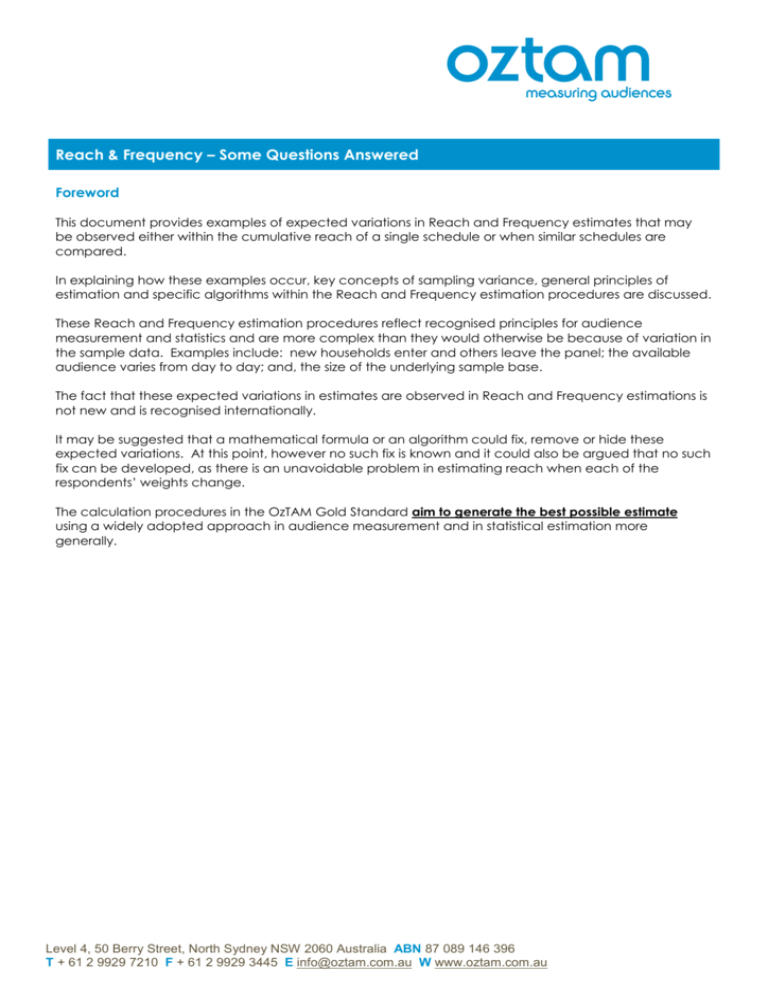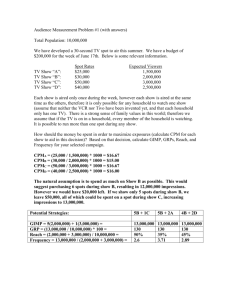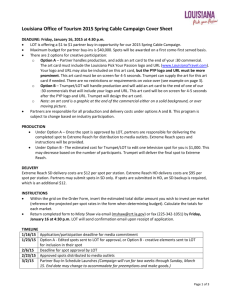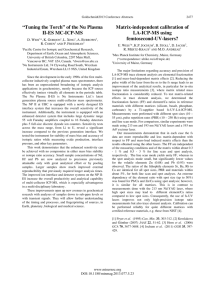Reach and frequency estimates
advertisement

Reach & Frequency – Some Questions Answered Foreword This document provides examples of expected variations in Reach and Frequency estimates that may be observed either within the cumulative reach of a single schedule or when similar schedules are compared. In explaining how these examples occur, key concepts of sampling variance, general principles of estimation and specific algorithms within the Reach and Frequency estimation procedures are discussed. These Reach and Frequency estimation procedures reflect recognised principles for audience measurement and statistics and are more complex than they would otherwise be because of variation in the sample data. Examples include: new households enter and others leave the panel; the available audience varies from day to day; and, the size of the underlying sample base. The fact that these expected variations in estimates are observed in Reach and Frequency estimations is not new and is recognised internationally. It may be suggested that a mathematical formula or an algorithm could fix, remove or hide these expected variations. At this point, however no such fix is known and it could also be argued that no such fix can be developed, as there is an unavoidable problem in estimating reach when each of the respondents’ weights change. The calculation procedures in the OzTAM Gold Standard aim to generate the best possible estimate using a widely adopted approach in audience measurement and in statistical estimation more generally. Level 4, 50 Berry Street, North Sydney NSW 2060 Australia ABN 87 089 146 396 T + 61 2 9929 7210 F + 61 2 9929 3445 E info@oztam.com.au W www.oztam.com.au Reach & Frequency – Some Questions Answered continued Introduction The OzTAM Reach and Frequency calculations are performed in a standard way to provide consistent results across different analysis software used in the market. Any Reach and Frequency calculation procedure is attempting to describe the behavior, over time, of a sample of respondents and their media consumption. In reality, panel surveys rarely provide a completely continuous sample. While panel based audience measurements provide considerable continuity, day to day variations in the sample are still inevitable due to households being added or dropped or not available for reporting (intab). These day to day panel variations influence Reach and Frequency estimates. This document gives examples and explanations of the following expected variations in the estimates: • • • • Total Reach; Incremental Reach; Reach Percentage Results; and 2+, 3+, …..n+ Reach Declining within a Schedule. These expected variations have long been observed in Reach and Frequency estimations and are recognised internationally. The calculation procedures in the Gold Standard aim to generate the best possible estimate for the specified schedule being processed. For example, if you re-specify a schedule to include extra days of data, then the procedure completely recalculates the results for that schedule. A new best estimate is calculated using all the data involved in the re-specified schedule. This is a widely adopted approach in audience measurement and in statistical estimation more generally. Level 4, 50 Berry Street, North Sydney NSW 2060 Australia ABN 87 089 146 396 T + 61 2 9929 7210 F + 61 2 9929 3445 E info@oztam.com.au W www.oztam.com.au Page 2 Reach & Frequency – Some Questions Answered continued Sampling Variance Further Explained The day to day changes in the sample will impact on Reach and Frequency calculations and there are several ways in which the sample changes. If spots are added to a schedule, bringing in a new day: • • • Some people will continue to be available for reporting for that new day; Some people will become available for reporting; and Some people will no longer be available for reporting. If one adds or removes days from a schedule specification: • • • The sample will vary; The average weight for each person involved in the analysis will vary; and If the schedule being evaluated is for a target audience with a floating UE, then the schedule UE will vary. The universe estimate (UE) for the target audience in a Reach and Frequency schedule can be either “fixed”, that is, it does not change from day to day, or “floating”. Within OzTAM data, key industry population segments are set to fixed UEs. Other population segments are not directly set and will have small day to day variations in their sum of weights, leading to floating UEs, that is, they change from day to day. The impact of sampling variance is also affected by the size of the sample available for reporting over the duration of the schedule and the extent to which the reporting sample varies on a day to day basis. The smaller the sample base for a target audience, the more variable the results will be. A small average daily sample may exaggerate the impact of respondents moving in and out of the sample. For a target audience with a much larger sample the impact would still exist, but to a lesser degree. Reach and Frequency estimates are based on a sample of people. An advertising schedule is based on particular days, and for each of those days, there is a sample of people who are available to contribute their data. From day to day the reporting sample will be similar but not identical. The variations in the day to day samples will affect a person’s average weight and also impact target audiences with floating UEs. Additionally, each respondent is given a unique weight for each day that they are available for reporting (intab). The weights are used in surveys to adjust and project the sample to the population. The weights vary for each respondent from day to day because the structure of the sample available for reporting varies. Level 4, 50 Berry Street, North Sydney NSW 2060 Australia ABN 87 089 146 396 T + 61 2 9929 7210 F + 61 2 9929 3445 E info@oztam.com.au W www.oztam.com.au Page 3 Reach & Frequency – Some Questions Answered continued Common Questions: 1. Total Reach (page 5) “Why, when I add a spot to a schedule, can the estimate of the total reach decline?” 2. Incremental Reach (page 6) “How can an extra spot deliver more incremental reach than viewers for that spot?” 3. Reach Percentage Results (page 7) “The cumulative reach in thousands up to a particular spot does not change when the schedule is extended, so why do the percentage reach results change?” 4. 2+, 3+, …..n+ Reach Declines within a Schedule (page 8) “Why can the 2+, 3+, …..n+ reach estimate decline at certain spots within a schedule?” Level 4, 50 Berry Street, North Sydney NSW 2060 Australia ABN 87 089 146 396 T + 61 2 9929 7210 F + 61 2 9929 3445 E info@oztam.com.au W www.oztam.com.au Page 4 Reach & Frequency – Some Questions Answered continued Total Reach Question 1 “Why, when I add a spot to a schedule, can the estimate of the total reach decline?” The actual total reach for a schedule would stay the same or increase if you were to add a spot to the schedule. But, the Reach and Frequency estimation procedure (used to estimate an actual value) may result in the estimated total reach declining in a schedule with an additional spot. The addition of a spot introduces new information, thus a new best estimate on this updated schedule is derived. An example: Consider a schedule containing four spots listed below, the estimated total reach is 42,416. If we create a second separate schedule which is the same but with an additional spot, the new estimate total reach is 41,355 (i.e. slightly lower than the estimate based on a schedule containing the first four spots only). A case where estimated total reach declines 4 Spot Schedule Estimated 1+ Reach 5 Spot Schedule Spot 1 Spot 1 Spot 2 Spot 2 Spot 3 Spot 4 Estimated 1+ Reach Spot 3 42,416 Spot 4 Spot 5 41,355 Explanation: The Reach and Frequency calculation procedures in the OzTAM Gold Standard are based on a well recognised philosophy of using all available data to generate the best estimates for the schedule being processed. In the calculations the survey data is weighted to a universe estimate (UE) so the results from the sample can be used to estimate the audience for entire target population. Unlike TARP estimates which only use weights from the relevant single day, and so do not change, the calculation of reach is more challenging. Reach is calculated by considering if each respondent saw one or more spots in the schedule. These spots can be on different days and respondents have different weights on the different days. For this reason, an average weight is used for each respondent. Reach estimates use the average weight across all days in the schedule. Using an average weight can cause a variation as a spot is added or removed. If the additional spot is in a new day, then the average weights will change for the respondents. This can change the estimates for the total reach, as demonstrated above. Level 4, 50 Berry Street, North Sydney NSW 2060 Australia ABN 87 089 146 396 T + 61 2 9929 7210 F + 61 2 9929 3445 E info@oztam.com.au W www.oztam.com.au Page 5 Reach & Frequency – Some Questions Answered continued Incremental Reach Question 2 “How can an extra spot deliver more incremental reach than viewers for that spot?” The extra actual reach that a spot delivers cannot exceed the actual audience for that spot. The Reach and Frequency estimation procedure, however, may give an estimated incremental reach that is greater than the estimated audience for that spot. An example: The example below is based upon a 36 spot schedule where the estimated reach increment of spot 12 is 2,924, but the estimated audience (or TARP 000s) for spot 12 is only 2,510. A case where the increase in the reach is greater than the TARP/audience for the spot TARP 000s Estimated 1+ Reach Estimated 1+ Reach increment Spots 1 to 10…… Spot 11 6,898 73,137 Spot 12 2,510 76,062 2,925 Spots 13 to 36….. Explanation: The Reach and Frequency calculation procedures in the OzTAM Gold Standard are based on generally accepted principles of using all available data to generate the best estimates for the schedule being processed. In the calculations the survey data is weighted to a universe estimate (UE) so the results from the sample can be used to estimate the audience for entire target population. General practice is to adopt the best estimate for the 1+ reach and to calculate the Reach and Frequency estimates across the whole schedule to maintain internal consistency and to preserve the relationship of the schedule’s overall TARP estimates and exact reach estimates. In the example, the incremental reach between spot 11 and spot 12 (2,925) is the difference between the best estimate for 1+ reach based on the sample and average weights for all 12 spots and the best estimate for 1+ reach based on the sample and average weights for the first 11 spots only. The average weights for the 11 spot calculation is updated when a spot is added. That is, the average weights used to calculate 1+ reach to spot 12 will be updated to derive the best estimate using all the available data to spot 12. TARP estimates only use weights from the relevant one day and so do not change, however reach estimates are calculated by considering if each respondent saw one or more spots in the schedule. These spots can be on different days and respondents have different weights on the different days. For this reason, an average weight is used for each respondent. Reach estimates use the average weight across all days in the schedule. Thus for any one spot the weight used in the reach calculation is different to that used in the TARP calculation, which can lead to a slightly higher incremental reach than spot TARP. Level 4, 50 Berry Street, North Sydney NSW 2060 Australia ABN 87 089 146 396 T + 61 2 9929 7210 F + 61 2 9929 3445 E info@oztam.com.au W www.oztam.com.au Page 6 Reach & Frequency – Some Questions Answered continued Reach Percentage Results Question 3 “The cumulative reach in thousands up to a particular spot does not change when the schedule is extended, so why do the percentage reach results change?” An estimated percentage reach uses the thousands estimates of reach and the thousands estimates of the target universe. While reach may stay the same, the average target universe estimate (UE) will differ between schedules if the target audience has a floating UE. An example: Consider two schedules; one with 36 spots and another with an addition 6 spots on top of the original 36 spot schedule (42 spots in total). The estimated reach in thousands for the first 3 spots does not change and is 41,030 in both schedules. But the estimated reach percentage does change, from 23.4% to 23.3%. A case where the estimated 1+ reach % differs with floating universe estimates 36 Spot Schedule Estimated 1+ Reach 000s Estimated 1+ reach % 42 Spot Schedule Spots 1 to 2…… Spot 3 41,030 Spots 4 to 36…. Estimated 1+ Reach 000s Estimated 1+ Reach% Spots 1 to 2…. 23.4% Spot 3 41,030 23.3% Spots 4 to 42…. This example is based upon a target audience with a floating UE where the sum of weights varies slightly from day to day. This may be observed in other reach percentage estimates, not just 1+ reach. Explanation: The Reach and Frequency calculation procedures in the OzTAM Gold Standard are based on an internationally accepted practice of using all available data to generate the best estimates for the schedule being processed. In the calculations the survey data is weighted to a universe estimate (UE) so the results from the sample can be used to estimate the audience for entire target population. The universe estimate (UE) for the target audience in a Reach and Frequency schedule can be either “fixed”, that is, it does not change from day to day, or “floating”. Within OzTAM data, key industry population segments are set to fixed UEs. Other population segments are not directly set and will have small day to day variations in their sum of weights, leading to floating universe estimates, that is, they do change from day to day. Thousands measures for reach are converted to percentage results by dividing them by the average universe estimate for the entire schedule. For a schedule based on a target audience with a floating UE, the percentage reach will change even though the thousands stay the same, as demonstrated in the example above. Level 4, 50 Berry Street, North Sydney NSW 2060 Australia ABN 87 089 146 396 T + 61 2 9929 7210 F + 61 2 9929 3445 E info@oztam.com.au W www.oztam.com.au Page 7 Reach & Frequency – Some Questions Answered continued 2+, 3+, ….n+ Reach Declines within a Schedule Question 4 “Why can the 2+, 3+, ….n+ reach estimate decline at certain spots within a schedule?” The actual 2+, 3+, ….n+ reach would stay the same or increase if one were to add a spot to a schedule. But, the Reach and Frequency estimation procedure (used to estimate an actual value) may result in the estimated 2+, 3+, ….n+ declining in a schedule with an additional spot. The addition of a spot introduces new information and internal consistency is maintained. An example: An extra spot delivers a reduction in the 2+ reach from 42,585 to 42,313. A case where an added spot show a 2+ reach decline 11 spot schedule 12 spot schedule Estimated 1+ Reach Spots 1 to 10…. 73,137 76,061 Estimated 2+ Reach 42,585 42,313 Explanation: The Reach and Frequency calculation procedures in the OzTAM Gold Standard are based on a widely adopted statistical approach of using all available data to generate the best estimates for the schedule being processed. In the calculations the survey data is weighted to a universe estimate (UE) so the results from the sample can be used to estimate the audience for entire target population. The general practice is to adopt the best possible estimate for the 1+ reach and to calculate the Reach and Frequency estimates across the whole schedule to maintain internal consistency and to preserve the relationship of the schedule’s overage TARP estimate and exact reach estimates. The Reach and Frequency calculation procedures ensure that the 1+ reach does not decline when spots are added to a schedule. The average weights used in the calculations may change when a spot is added, or when an adjustment to the 1+ reach is applied (ensuring it does not decline). This may result in the estimated 2+, 3+, ….n+ reach declining, as a result of the requirement to maintain internal consistency between the overall TARP and the exact reaches. Level 4, 50 Berry Street, North Sydney NSW 2060 Australia ABN 87 089 146 396 T + 61 2 9929 7210 F + 61 2 9929 3445 E info@oztam.com.au W www.oztam.com.au Page 8






